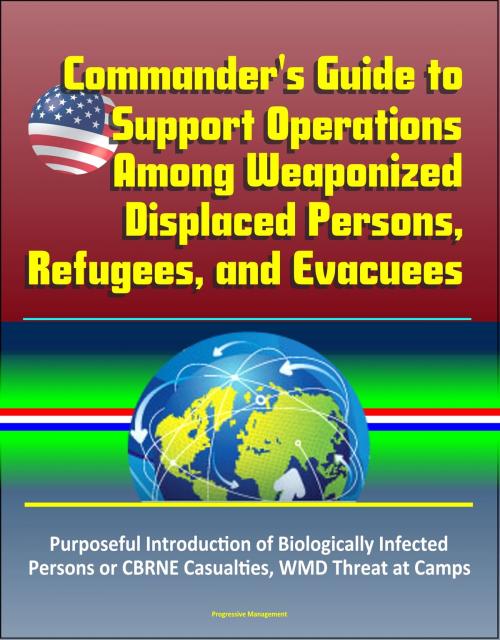Commander's Guide to Support Operations Among Weaponized Displaced Persons, Refugees, and Evacuees, Purposeful Introduction of Biologically Infected Persons or CBRNE Casualties, WMD Threat at Camps
Nonfiction, History, Military, Biological & Chemical Warfare, Social & Cultural Studies, Social Science| Author: | Progressive Management | ISBN: | 9781370631506 |
| Publisher: | Progressive Management | Publication: | March 13, 2017 |
| Imprint: | Smashwords Edition | Language: | English |
| Author: | Progressive Management |
| ISBN: | 9781370631506 |
| Publisher: | Progressive Management |
| Publication: | March 13, 2017 |
| Imprint: | Smashwords Edition |
| Language: | English |
This excellent report has been professionally converted for accurate flowing-text e-book format reproduction. The use of chemical and biological weapons on the battlefields of history is not a new phenomenon. Although this practice is contrary to international treaties and customs, it has not precluded the use of these weapons by state and non-state actors against military, political, or civilian targets. Chemical and biological weapons use during the Iran-Iraq war in the 1980s and the use of chemical weapons in Syria in 2013 demonstrate that our collective security is threatened by actors willing to defy the international community. The threat of chemical and biological weapons use is increased as these are relatively inexpensive to produce and can be delivered by a variety of methods, making them an asymmetric threat of catastrophic potential. The psychological, health, and logistical implications of displaced persons fleeing a real or perceived chemical, biological, radiological, nuclear, and enhanced conventional weapons (CBRNE) environment will create complex mission command and support requirements requiring innovative and agile responses.
Responding to a crisis of the magnitude associated with the purposeful introduction of CBRNE casualties into a displaced person, refugee, and evacuee (DPRE) environment would almost certainly require military forces — particularly U.S. military forces — with the skills necessary to rapidly deploy for consequence management, and operate in what promises to be a very complex and chaotic environment. The ability to provide streamlined and integrated CBRNE and medical capabilities will be essential. Military forces will need to create the space necessary for aid agencies to operate and provide a synchronized interagency and intergovernmental response. Time between detection, analysis, understanding, and deployment could be very short and predeployment training and planning timelines will be limited.
Chapter 1 - Medical Considerations for Weaponized Attacks on Displaced Persons, Refugees, and Evacuees * Chapter 2 - Protection Through Prevention: Defending At-Risk Displaced Person Populations Against Disease * Chapter 3 - Risk, Prevention, and Mitigation of Infected Displaced Persons * Chapter 4 - Preventing Slow Extinction: Combating the Use of Weaponized Displaced Persons, Refugees, and Evacuees to Inflict Generational Genocide * Chapter 5 - Weaponized Displaced Persons, Refugees, and Evacuees: A Potential Threat to the Army's Ethical Climate and Organizational Culture * Chapter 6 - Weapons of Mass Destruction and the Humanitarian Aid Response: An All Hands Approach to a Global Threat * Chapter 7 - Understanding Organizational Culture: Nongovernmental Organization and Communication Barriers * Chapter 8 - The Tool Kit: Information Dissemination in a Weaponized Displaced Persons Relief Effort * Chapter 9 - Displaced Persons Camps and the Potential for Weaponized Disease Attacks * Chapter 10 - Mitigating Risks of Deliberate Biological Contamination * Chapter 11 - Security Considerations: Principals to Consider While Handling Displaced Persons, Refugees, and Evacuees in a Weapons of Mass Destruction-Affected Environment * Chapter 12 - Minimum Standards of Water, Sanitation, and Hygiene for a Displaced Person, Refugee, and Evacuee Camp and Their Role in Reducing or Preventing the Spread of Infectious Diseases * Chapter 13 - Integrating Female Engagement Teams into Displaced Persons, Refugees, and Evacuees Operations * Chapter 14 - Leadership: A Cure for Fear and Uncertainty
This excellent report has been professionally converted for accurate flowing-text e-book format reproduction. The use of chemical and biological weapons on the battlefields of history is not a new phenomenon. Although this practice is contrary to international treaties and customs, it has not precluded the use of these weapons by state and non-state actors against military, political, or civilian targets. Chemical and biological weapons use during the Iran-Iraq war in the 1980s and the use of chemical weapons in Syria in 2013 demonstrate that our collective security is threatened by actors willing to defy the international community. The threat of chemical and biological weapons use is increased as these are relatively inexpensive to produce and can be delivered by a variety of methods, making them an asymmetric threat of catastrophic potential. The psychological, health, and logistical implications of displaced persons fleeing a real or perceived chemical, biological, radiological, nuclear, and enhanced conventional weapons (CBRNE) environment will create complex mission command and support requirements requiring innovative and agile responses.
Responding to a crisis of the magnitude associated with the purposeful introduction of CBRNE casualties into a displaced person, refugee, and evacuee (DPRE) environment would almost certainly require military forces — particularly U.S. military forces — with the skills necessary to rapidly deploy for consequence management, and operate in what promises to be a very complex and chaotic environment. The ability to provide streamlined and integrated CBRNE and medical capabilities will be essential. Military forces will need to create the space necessary for aid agencies to operate and provide a synchronized interagency and intergovernmental response. Time between detection, analysis, understanding, and deployment could be very short and predeployment training and planning timelines will be limited.
Chapter 1 - Medical Considerations for Weaponized Attacks on Displaced Persons, Refugees, and Evacuees * Chapter 2 - Protection Through Prevention: Defending At-Risk Displaced Person Populations Against Disease * Chapter 3 - Risk, Prevention, and Mitigation of Infected Displaced Persons * Chapter 4 - Preventing Slow Extinction: Combating the Use of Weaponized Displaced Persons, Refugees, and Evacuees to Inflict Generational Genocide * Chapter 5 - Weaponized Displaced Persons, Refugees, and Evacuees: A Potential Threat to the Army's Ethical Climate and Organizational Culture * Chapter 6 - Weapons of Mass Destruction and the Humanitarian Aid Response: An All Hands Approach to a Global Threat * Chapter 7 - Understanding Organizational Culture: Nongovernmental Organization and Communication Barriers * Chapter 8 - The Tool Kit: Information Dissemination in a Weaponized Displaced Persons Relief Effort * Chapter 9 - Displaced Persons Camps and the Potential for Weaponized Disease Attacks * Chapter 10 - Mitigating Risks of Deliberate Biological Contamination * Chapter 11 - Security Considerations: Principals to Consider While Handling Displaced Persons, Refugees, and Evacuees in a Weapons of Mass Destruction-Affected Environment * Chapter 12 - Minimum Standards of Water, Sanitation, and Hygiene for a Displaced Person, Refugee, and Evacuee Camp and Their Role in Reducing or Preventing the Spread of Infectious Diseases * Chapter 13 - Integrating Female Engagement Teams into Displaced Persons, Refugees, and Evacuees Operations * Chapter 14 - Leadership: A Cure for Fear and Uncertainty















